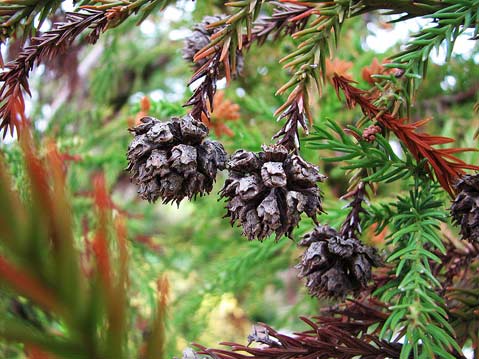Uncommon Conifers
The Tallest, Oldest, Widest Trees in the World

They dominate vast tracts of land across the northern regions of the northern hemisphere and clothe the slopes of the majority of mountain ranges both northern and southern. There are even a few that tough it out in warm and dry regions worldwide. They evolved successful reproductive and survival adaptations long before flowering plants, and their fossils date back to the Carboniferous.
A conifer (Sequoia, coast redwood) is possibly the tallest tree in the world at more than 379 feet. Another conifer (Pinus longaeva, the bristlecone pine) is possibly the oldest tree in the world at about 5,000 years of age, and there is a conifer that beats all diameter records—El Árbol del Tule, a type of cypress (Taxodium mucronatum) that has been growing just outside of Oaxaca city in Mexico, is 119 feet in circumference at chest height.
Conifers are useful for timber, resins, and edible seeds of course, but conifers can also fill a number of landscaping uses. Most are evergreen, the exceptions being dawn redwood (Metasequoia glyptostroboides) and larches (Larix species). Pines are common in all zones, spruces and cedars are beloved by more northern gardeners, and podocarps (Podocarpus and relatives) find uses in southern states. There are a few unique conifers, though, that have all the requisite characters but need a little more exposure.
If you visit Japan, the principle conifer that you will see is Cryptomeria japonica. It is grown for timber and for ornamental purposes. This type of tree grows as an upright conical evergreen. It is fast-growing and may eventually reach 100 feet in height with a flaring base up to 30 feet in diameter. The bark is somewhat furrowed and ornamental and the finely textured foliage is a summery green during the warm months. Most selections sport a different color in winter with brownish to purplish hues providing an interesting foil to other evergreens. The species is naturally quite variable, and there are some dwarf and intermediate varieties that have been cultivated for centuries.
Cunninghamia lanceolata, commonly called China fir, may remind some Southern California gardeners of an Araucaria with its sharp-pointed leaves; however, the texture is finer than the bunya bunya, and the tree grows slowly to a much more manageable size. It may only reach 30 feet after many years. Winter cold spells will cause reddening of the leaves and sundowner winds may cause distress, so irrigate well during hot, dry spells.
Not as easy to find in the nursery trade yet, Dacrycarpus species hail from New Zealand (and a few spots in Southeast Asia). There are upright as well as horizontal forms of several species. Their foliage is rather sparser than some other evergreens, and they may never quite achieve a healthy-looking green. One nurseryman described it thus: “If ever a tree looked dead, and still wasn’t, this is it.” The bronzy color is striking in its own right, however.
The truly unique umbrella pine, Sciadopitys verticillata, stands alone in its own family. Fleshy needle-like leaves are clustered at the ends of branchlets like the radiating spokes of a parasol. In its native Japan, it is a regal forest tree still harvested for its timber, and it is widely used as an ornamental around temples. There, it may reach 100 feet in height, while in gardens, it remains much smaller. Partial to neutral and acidic soils, it requires lots of compost and mulch to remain a rich green in most southern California gardens. It takes well to containers and is a favorite bonsai candidate.



